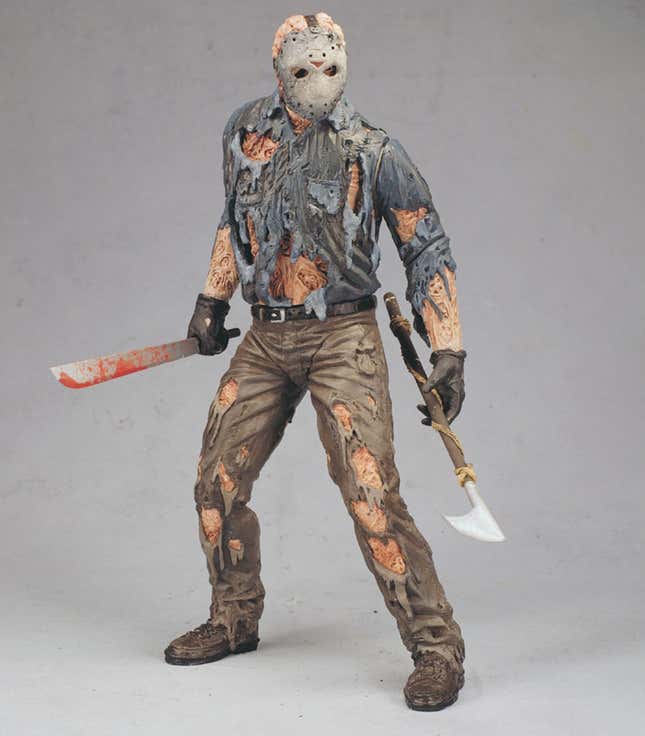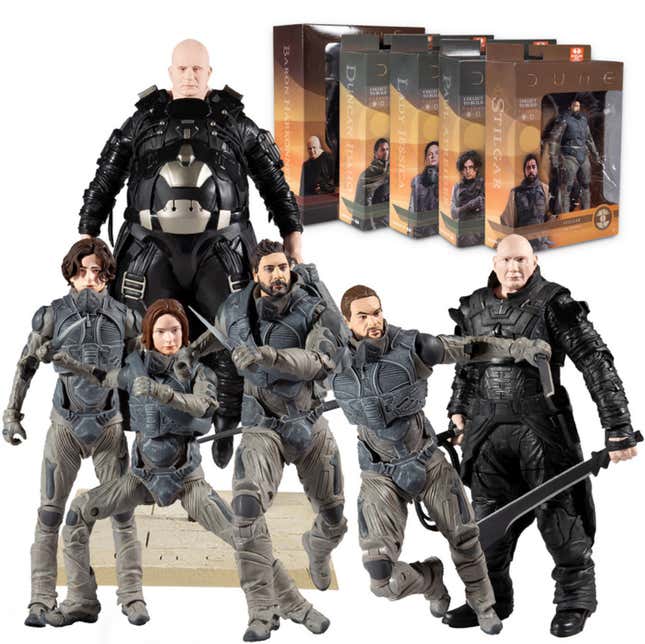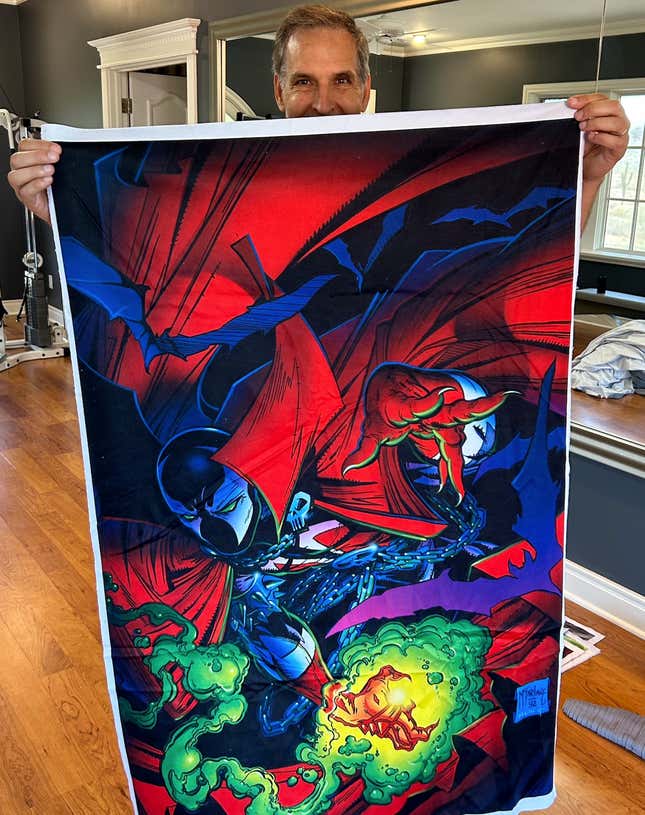
Spawn, DC Multiverse Toys, Comic-Con
When you think about all things pop culture, few people check as many boxes as Todd McFarlane. The iconic comic book artist best known for his work on Spider-Man and creating Spawn not only keeps a high profile in that field, but he’s got his own toy line, while also dabbling in TV, movies, video games, you name it.
That means, at a place like San Diego Comic-Con, where all of those things come together under one roof, few people are as busy as Todd McFarlane. He’s on panels, he’s signing autographs, he’s debuting toys, and he’s got his own booth. A booth that, starting today on WhatNot, you can bid on pieces of.
This week, io9 talked to McFarlane about that new venture but also much more. We discussed how this year’s strike impacted Comic-Con, how he’s been able to keep McFarlane Toys a viable brand, and what changes he’s seen in that space over the past several years, as well as his thoughts on the current state of the superhero genre in movies. Check it all out below.
This interview has been edited for length and clarity.

Germain Lussier, io9: Since your Comic-Con booth is up for auction today, I want to start with Comic-Con. As someone who’s been part of that industry and going to that event for so long, what are your thoughts now, in retrospect, of how it was this year without the Hollywood presence that’s been so prominent in the past few decades?
Todd McFarlane: It was interesting because I think by the time Hollywood, especially on the actor side, decided to go on strike, and said that they didn’t want their people to go to conventions and things and promote and stuff, it was a few days before Comic-Con. So it was kind of too late for (fans) to back out, right? So what that meant was that I thought that the attendance was pretty close to normal. It’s just that people had to reallocate their time and where they were going to spend it. Normally they’d get in a lot of lineups for the celebrities and they hang out in maybe Hall H for a day or something like that. But a lot of that was taken away from them. So they’d go, “Well, I’m here. What’s plan B?” So they had to go to Plan B. I didn’t hear one person say they were bummed out by it. Now maybe they got it out of their system the four days before when they found out they couldn’t back out and they had all their reservations taken care of. But I thought it was a pretty, pretty chill event and everybody seemed to be having a good time.
io9: Yes I agree. Now, I’ve been into McFarlane Toys since you did that amazing Movie Maniacs line back in the day, so I’ve loved seeing the resurgence of the brand in the last couple of years. What’s been your approach to bringing the company back into the licensed figure space?
McFarlane: Well, I mean, on the comic book front, we were getting close to issue 300. So that happened about 2019 and gave me a sort of a catalyst to basically recalibrate everything. And then the toy front, we ended up picking up a triple-A brand. I’ve always said, “Guys, you give me Transformers and G.I. Joe and Star Wars and Marvel and Batman, I can sell those.” So for the first time in, you know, 25 years at my company, we were able to get a piece of one of those big brands, and that was the DC Multiverse. So that started in 2020. And so we’ve got Superman and Batman. I mean, I didn’t get any smarter, right? It has nothing to do with me! It’s that I now have access to giant recognizable brands and then I can put my spin on it. But, you know, I’ve been putting my spin on toys for a long time. I just haven’t had the opportunity to do it with brands that the globe knows.

io9: So what have you learned in that time? When you talk about your spin on it, is there anything specific that you’ve learned in the last 25 years that aided in your the current success of the brand?
McFarlane: Well, the size of my company has always been a blessing and a curse, right? Because when you sort of compare it to some of the big Fortune 500 companies, the public companies, I can’t really do the same thing that they can. But because of my size, I can move faster and be more nimble and that’s an advantage. And I don’t have to maximize shareholder value every 90 days which is what public companies legally are bound to do. So one of the things is that we were able to make figures that a lot of people had never made. And the reason is because the look of that character and the body parts or whatever couldn’t be reused for 10 other figures.
The big companies are very efficient at reusing parts, right? So if you look at a company like Lego, they have a formula that is like X amount has to be reused pieces that already exist, and then we put in X amount of new pieces so it can actually build whatever it is that we’re building. And it works. And action figures are kind of sort of the same. I mean, we’ve seen it forever. You know, in the ‘60s and ‘70s (they) kind of made one body and it works for everybody. Barbie did the same thing. But I just go, “No, let’s just do some unique stuff. And who cares if I can’t reuse the mold.” And it was a little bit of a surprise that somebody would do that to the magnitude that we’ve done it for our company, both on the Warner Brothers end but more importantly, which is sort of the bigger thing to the consumer, is I’m now able to do characters (they’ve never seen as toys). It’s not that I did them great or I do them better than anybody else. I just did it for the first time. Like you’ve never been able to buy that character. So people are like, “Oh, my gosh, I can buy that character? I’ve been collecting DC or superhero stuff for 25 years, and I can’t buy that on eBay.” So here I am. Now we can do it. So I mean, new and not repeating the same tricks that everybody else has done for the last 25, 30, 40 years. Like it. I think it helped.

io9: That is a very good answer and it leads into my next question. You talked about how the bigger brands have their formula and your brand is to not follow that formula, but beyond that how do you think the licensed figure industry has changed over the year?
McFarlane: There are two big changes. One is that the internet came along. So that changed it for everybody on a lot of levels. And two is that the blueprint that I laid down when we first came in as a company… we were the only ones doing it, right? “Hey, let’s just do some sort of highly detailed, add some extra paint and make it look a little more realistic and just do some cool, cool stuff. Oh, by the way, don’t worry about whether mom and six-year-olds are buying it for their birthday parties. Let’s sell it to a 14-and-up crowd. People who are essentially buying products for themselves. For their collection, for their enjoyment.”
And so we got out of the gate and I think helped prove that it could be done. Became one of the pioneers of sort of doing it. And now the great thing is, and it was supposed to happen, is that if it works and I succeed, people will hopefully take a page from the playbook and repeat it so that toys as a whole, across the board, even arguably the Fortune 500 toys like Hasbro and Mattel, that those would also get better. And it would be better for the community of collecting. And I’m in competition now with, you know, 40 companies that do a brilliant job with their product, too. That just forces me to stay on my toes. So I think the change is the toys have gotten better, cooler, and you don’t have to go to a big box store to find all these brands that normally would have never existed because you can only put so many of them in aisle nine—boys’ action figures— at mass retailers. But now we have the internet and there are 100 ways you can sell niche products, if you want to call it that.

io9: Earlier, you mentioned a lot of the huge brands and DC is obviously one of those. Have you ever sought out any of these other licenses and not been able to get them?
McFarlane: Yeah, all of them.
io9: (Laughs)
McFarlane: So I have this wish that every contract that anybody ever signed for toys should have like paragraph 44, last one before the signature, that says, “Oh, and one more stipulation: McFarlane Toys gets to make one figure.” I just would like to make one Transformer, one Star Wars, one Marvel, one whatever the hot video game is, one whatever the hot movie is. Just let me do one. I don’t need to do all of it. I understand that other people can do it. They have the tonnage programs and they have billions of dollars behind them in the big giant machine. Just let me do one. Anyway, we’ll see. It took a long time to get the DC Multiverse. And maybe I’ll be able to figure out a way to pick off something in the future of one of those. Just something small. They’re never going to give me anything meaningful, right? So it just would have to be something like in the corner. But just so I can go, here. Here’s how I would do it.
io9: Well, that would be awesome. Moving off toys, you’ve talked a lot about trying to make a new Spawn movie in the past and I know your company has a few other shows in development. If the strikes ended today, because that’s obviously the biggest impediment for anything right now, what would be the first thing that would come out for you guys, that you can talk about of course?

McFarlane: My guess is that everybody is working on a project and Spawn’s no different, but everybody’s been thinking about it during the strike. Whatever project they were working on or whatever their passion projects are. So my guess is that as soon as the strike’s over the people involved, especially on the writing side of it, they’ll finish the script and then we’ll sort of back and forth on it a little bit and then we’ll go into town, and say, “Hey, here we go. This is the movie we want to make. Who’s interested?” That was the plan. That was the original plan, we were supposed to be doing it this summer.
io9: Speaking of Hollywood, I’d love to get your take on the current state of the superhero movie. This year has seen Marvel stumble with Ant-Man 3, DC stumble with The Flash, and more. Do you believe that there’s a thing called “superhero fatigue,” or do you think it’s more the quality of the movies?
McFarlane: I think there’s a couple of things. The quality of any film, any genre (is important). People say “I can’t sell a Western movie.” Of course, you can. You can’t sell a bad Western movie. And then your marketing. If you put it in a bad time up against 10 other movies people want to go see, it’s going to get buried, right? So you’ve got that. And then just sort of gauging whether people are in the mood for that genre more than another one. Sometimes rom-coms become sort of the flavor of the month for a while or whatever else.
But I put superhero movies in the same category as action movies. They’re just action movies and action movies have been around forever, right? Van Damme. Schwarzenegger. Stallone. Seagal. This is just an extension of it. So, yes, at some point, if some of those action movies got cheesy and they went to the well too often, we’d move on. But then all of a sudden, you know, The Matrix comes along or some other new one and we go, “Oh my God, there it is.” So somebody is going to figure it out. I mean, again, I don’t think (there’s superhero fatigue). It’s like saying that there’s been too many baseball games played and we have baseball fatigue. No. Just give me a good team that I can root for and make it worth my money and I’ll come.
io9: Last thing, bringing it back to Comic-Con and the auction for pieces of your booth, tell me a bit about WhatNot and what fans have the chance to bid on?

McFarlane: Well, the simple part is that every year we make a booth and we spend a lot of money and we put graphics up because we’re trying to do current events and then we just have to throw it away. So one, it’s a shame to throw it away and two, what we’re throwing away, people probably would sort of get a kick out of. So we’re going to see. We came up with this cool design. It looked really good in San Diego, I thought. And it was designed in such a way that we could cut it up into 24 parts and then sell each one of them. So they are basically giant cloth posters that I’ll sign and a couple of other creative people have signed.
WhatNot is an experiment to me. I’m always looking for communities to interact with. And so I’m going to see if WhatNot is an addition. People go, “Hey, what else are you going to be doing?” I don’t know. Come back to me in four or five months. I’ll be a lot smarter, right? I’m experimenting here. And so we’re going to see whether the experiments are working or not. So it’s the same with anything else. I hope so. Fingers crossed.
For more on all things McFarlane, including his comics, toys, and more, visit his official website. To bid on pieces from his Comic-Con booth, head to this link or his WhatNot profile at this link.
Want more io9 news? Check out when to expect the latest Marvel, Star Wars, and Star Trek releases, what’s next for the DC Universe on film and TV, and everything you need to know about the future of Doctor Who.

